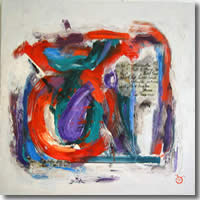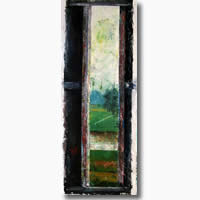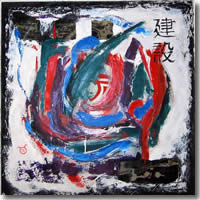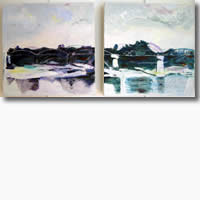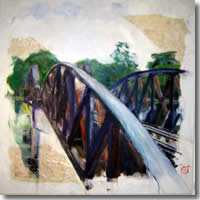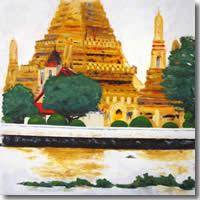Relative Journeys:River Kwai Revisited
Sally Grumbridge's very moving exhibition exploring her experiences as a tourist juxtaposted with her fathers as a prisoner of war in Thailand page 2.
Capitulation
Initially the Japanese left the prisoners to fend for themselves - they were given no food. After several weeks of boredom and hunger, it was learnt that their captors planned to use the vast numbers of prisoners as a work force. From Changi POW camp they were marched to Bukit Timah, where they built a Shinto memorial shrine on the golf course. The starting points for this abstract image are my father’s journal and the stamp on a piece of fabric I found amongst my his wartime possessions. The writing in the circle is archaic Japanese for ‘prisoner’ – I have also used this image as my ‘signature’ on all but one of the works in this exhibition.
Destination Unknown
After eight months of captivity, they were told they were to be sent to a better camp where there would be ‘better food, better conditions’. They were crammed into steel box cars (originally rice container wagons), 30-33 men and a guard to each car just 8ft x 18ft. The train journey took four days. During the day, the heat was stifling, at night, in the highlands of Malaya, they froze. There was no sanitation and very little food. My father said that seeing glimpses of nature (especially the butterflies) through the small opening on the train kept him going during that journey.
Construction
After arrival in Ban Pong, a transit camp deep in mud and filth, they were transported to the town of Kanchanaburi (Kan’buri, as the prisoners called it), and then marched the four miles to Tamarkan on the river Mae Khlong, where they were to build two bridges: one wooden and one steel. On this painting I have collaged copies of photos of the building of those bridges and the subsequent bombing of the steel bridge by the Allies in June 1945. The Japanese writing is the word for construction (of a bridge).
IF
The steel bridge (from a photograph taken in May 1943). One of the pieces of writing in the journal is the poem ‘If’ by Rudyard Kipling. It was one of my father’s favourite poems (he was always quoting from it). In the context of their plight, it must have been an important text. As the image of the bridge fades, so my father’s writing gets stronger.
The Bridge
Thanks to David Lean’s famous film, this has become an icon, a symbol of the FEPOW experience and also, somewhat ironically, a popular tourist attraction. I found it an emotional experience standing on that bridge 61 years on. It brought back memories of watching ‘Bridge on the River Kwai’ with my father, who kept shouting at the TV screen that ‘it wasn’t like that at all’, when all I wanted to do was enjoy a good film. Whilst the film’s inaccuracies have created a totally false impression of their story, it did at least bring to the world’s attention a piece of history that many felt had been totally sidelined. The etching collage is from ‘If’.
Bangkok Wat
Counting one to ten in Japanese with my father was always a bit of fun as a child. It was only when researching his story that I discovered a more sinister background to my father’s familiarity with Japanese numbers. In most of the camps, the roll-call or ‘tenko’, took place twice a day and the prisoners had to stand in rows of ten and shout their number. If they got it wrong, or were just too near the front of the line, a beating could easily follow. The Japanese are superstitious about writing the numbers four (shi) and seven (sit-shi) as the symbol for ‘shi’ also means death. More than two out of ten prisoners died during captivity.
